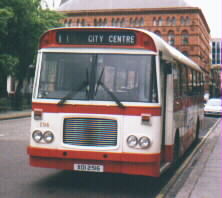
Citybus 2516 was missing its Bristol RE badge when parked in a deserted-looking Donegall Square East, one evening in May 1998

Citybus 2516 was missing its Bristol RE badge when parked in a deserted-looking Donegall Square East, one evening
in May 1998
Citybus obtained its first Bristol REs in 1976. Up until 1979 all the buses had dual doors. In 1979 they started obtaining single-door versions, and the last dual door buses were VOI-registered and delivered in 1981. I remember some of the dual door buses quite well in late 1996, but in early 1997 delivery of the new Volvo B10L low-floor buses started and the last dual-door REs were withdrawn.
The REs were numbered from 2003 to 2600, although those at the start and end of this range belonged to Ulsterbus, along with a substantial number in between. The REs left in service with Citybus today are from about 2476 to 2583, with plenty of gaps in between where buses have been maliciously destroyed over the years. None of these are very much at all more than 16½ years old, and most of the older ones have been scrapped, with some transferred to Ulsterbus where they are still in service. Ulsterbus have kept their REs much longer and several are now 20 years old. There are some comments about Bristol REs on the Ulsterbus Vehicle Types page
The Bristol REs stopped being made in 1984, and the last ones (2556-2559) went into service in September 1986. That was only 12 years ago, so it is likely that a lot of REs will remain in service for some time to come. In the 1980s there were a lot of second-hand Bristol REs, but these have all been sold back to England or burnt out and scrapped for a long time now.
Most of the REs in Falls Park depot have XOI numbers. There are also a few XOI-registered ones in Newtownabbey, an example being 2521 shown in the photograph below. There are also quite a few Bristol REs in Short Strand depot, nearly all of them being newer ones with AXI or BXI numbers, and a small assortment of REs are based in Great Victoria Street.
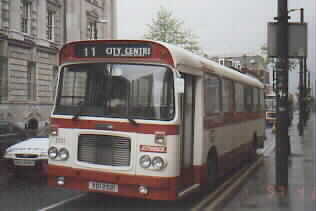
Citybus Bristol RE 2521 (XOI 2521) rests in Donegall Square South between
April showers in 1997, having arrived in the City Centre from Carnmoney
The Bristol REs are quite famous because they continued in production for Citybus and Ulsterbus after they had stopped being made for bus companies in England and Wales; the last REs now operating in those countries date from about 1975, the same year as the 2003 to 2600 range started being built for Ulsterbus and Citybus, so if they kept their buses for as long as a lot of the companies in England had they would still have something like 500 Bristol REs.
There are two types of Leyland Tigers in the Citybus fleet: 2601 to 2635 have Alexander N-Type Square bus bodies and were new in 1988-89, and 2636 to 2680, 1400-1407 and 1455-1481 have Alexander Q-Type Cityliner bodies and were new in 1991-92. The last two batches fit into the Ulsterbus fleet numbering range, which might possibly suggest that they were originally intended for Ulsterbus, but I'm not very sure about that.
Looking at the fleet at present, it would seem that the 1988 Tigers were the first new buses Citybus had bought for four years, but there were some Leyland Lynxes in between the last Bristol REs in 1984 and the first Tigers. These had HXI numbers, and in the early 1990s were sold to somewhere like Stevensons of Uttoxeter in England.
The first batch of Tigers, 2601 to 2610, had LXI numbers and were new in the middle of 1988. The second batch, 2611 to 2635, had NXI numbers and were new in 1988-89. The second batch are similar to the first except I think there is a very slightly different seating arrangement near the back.
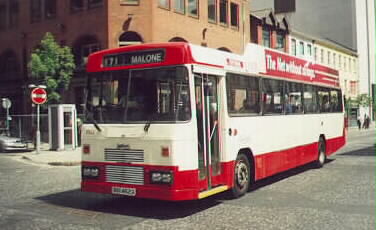
Citybus Leyland Tiger 2623 is seen here in Howard Street heading towards
Malone, one sunny morning in late May 2000
As I said before, these buses have N-Type square bus bodies. They are similar to the majority of Tigers in the Ulsterbus fleet, with the notable exception of being equipped with Gardner engines rather than Leyland, and the seating inside is different. The Citybus Tigers start with 3/4 person seats along each side of the bus over the front wheels; then on the left hand side there is a small buggy or luggage compartment on the floor while on the right hand side forward-facing seats start. Until halfway down the bus there are only single seats on each side, which means there is a lot of standing room in the large gangway between them. The single seats have a metal 'arm-rest' barrier on the gangway side to stop people falling off them. I find the single seats quite uncomfortable and always prefer to go further down to the back where there are double seats.
The last two or three seats on each side and the back seat on the Tigers and most Bristol REs in Citybus as well are made of hard plastic, which I think is a really good idea to discourage vandalism. Previously I think buses only really ever had all their seats hard or soft.
Although the buses have different engines from the Ulsterbus Tigers, they have the same gears etc. The semi-automatic gears seem a tiny bit jerkier than those on the Ulsterbus Tigers, and most Citybus drivers (I suppose used to driving Bristol REs where it doesn't make much difference) don't pause in neutral when changing gears on the Tigers. This can make for a very jerky and unsmooth journey sometimes.
Most of the LXI and NXI Tigers are based in Short Strand depot. There are also about 4 in Falls Park and one or two in Newtownabbey and Great Victoria Street.
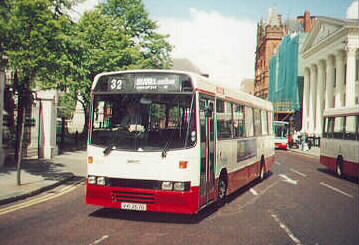
Leyland Tiger Cityliner 2676 (VXI 2676) negotiates the one-way system around
Belfast City Hall as it approaches the turn from Donegall Square East into South, on
the last Saturday in May 2000. This bus is non-standard in having the area around
its destination screen coloured black rather than the normal Citybus red.
Ulsterbus and Citybus bought 40 'Handybuses' (Dennis Darts with Wright Handybus bodywork) in 1994. About 15 of these, numbered approx. 624 to 640 went into service with Citybus, where at night time and weekends they are often used on main routes, and during the day on less heavily frequented routes. Examples I can think of are the 80 and 81 Grosvenor Road routes and 64 Downview, which are normally operated by Handybuses during the day. The photograph below shows 637 (CAZ 6637) displaying the Gilnahirk destination, which I think is quite unusual.
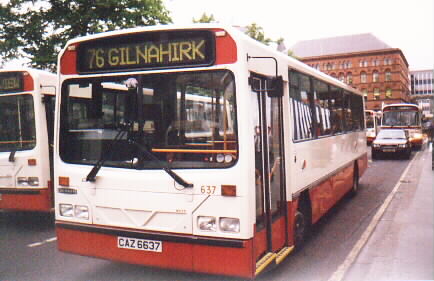
Citybus Handybus 637 is seen in Donegall Square East outside the Citybus
City Centre headquarters
The Handybuses have split-level steps and a low floor. The driver's seat is higher up than the other ones, at the normal level for a bus. There are 3 high seats facing into the bus above the front wheels on each side, and then low seats on each side, rising up over the engine at the back, the way the seating always seems to be on low floor buses. I prefer to sit near the back, because most of the seats are just too low down.
The buses seem to have quite powerful engines and handbrakes for their small size. Sometimes the whole bus seems to jump when the bus driver puts the handbrake on. There are automatic gears with a lever similar to that in automatic cars, on the driver's right.
I don't really like handybuses very much, mainly because they are small and low down. They can be quite nice however--warm and cosy feeling--when there aren't many other people on the bus, especially maybe at night time.
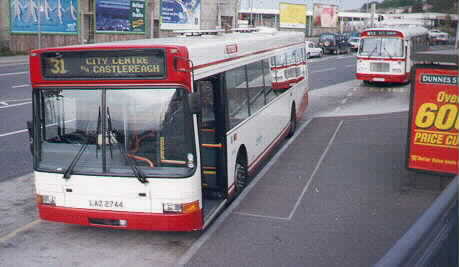
B10M / Alexander Ultra 2744 lays over at the Castlereagh Road stand at the Ormeau
terminus in Upper Galwally in Summer 1999, as a Bristol RE pulls up to the Cregagh Road
stand behind
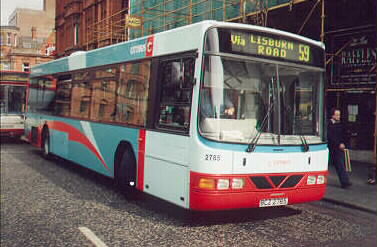
The driver of B10BLE / Wright Renown 2785 positions himself in his seat before
leaving Donegall Square East on a journey to Balmoral while an Ultra headed for Conway,
the other Lisburn Road route, waits in the background
Back to Citybus Page
Northern Ireland Bus Site |
| Index | Ulsterbus Page | Citybus Page | Lough Swilly Page | Links |